East Bay Resort, Reef Divers, South Caicos, TCIContents of this Issue: East Bay Resort, Reef Divers, South Caicos, TCI That Snorkel Can Save Your Life South Caicos, 2001: Will The Diving Be The Same? Conception Tragedy Leads to New Safety Rules Traveling Divers are Quarantined Do You Use a Backup Computer, Part II More on PFO, “That Perfectly Formed Hole” Starving Manatees Get Salad and a Warm Bath Editorial Office: Ben Davison Publisher and Editor Undercurrent 3020 Bridgeway, Suite 102 Sausalito, CA 94965 superb property, but the jury is out on the diving from the February, 2022 issue of Undercurrent
Dear Fellow Diver, It was heavenly to hit the surface and enjoy the calming sensation of clear, 82-degree November water. Indeed, a wonder to be diving again after 18 months of COVID-enforced abstinence.
So, what better place to get wet and explore seldom-dived reefs? After all, I've dived with Reef Divers at their three first-rate Cayman venues -- Little Cayman Beach Resort, Brac Reef, and Cobalt Coast. They are continuing their high standard here: when my spouse and I first entered our ocean-view one-bedroom suite and spotted a mesh bag to stash all my gear, I knew I was in a bona fide dive resort. However, I soon felt a bit put off when I learned that to reach the dive boat required a van trip to the dock. But the air-conditioned five-minute ride past salt ponds, flamingoes, wild donkeys, and even a wild horse was effortless. While they had no dive shop during my visit, they're completing construction on a shop behind the hotel. A strong breeze roiled the surface for the 15-minute boat ride to Dove Cay; below the visibility ran about 25 feet, far short of what turned out on other days to be a good 50-70 feet. I finned along the 20-foot bottom in the mild surge, passing numerous coral heads, which the Aussies endearingly call "bommies." At first, I was excited to look forward to beautiful diving, but my optimism took a hit as I realized that most of the hard coral was dead, drab, dull algae-brown. Sure, the common reef fish were there, so I'd hold my judgment after more dives. Diving got better at the Arch, a swim-thru at 60 feet, where a school of resident horse-eyed jack swirled about. We divers declined the opportunity to kick through, preferring to hang back and enjoy the jacks rather than scatter them. Along the bottom passed plentiful sea fans while checking for critters in barrel sponges with diameters as large as basketball hoops, some even larger. Along the way, I spotted queen angels, rock beauties, fairy basslets, lots of blue chromis, but no large schools of fish. Back in the day, many reefs in the Caribbean were, as we'd say, "teeming with fish," but not these days, it seems. At a nearby dive site called Grotto -- surface intervals are on the boat -- I encountered a small patch of healthy elkhorn coral, which I rarely see these days, and not far away, a nurse shark rested in the sand. Reef Divers, with their valet approach, make the diving quite effortless. After I stuffed our gear in the mesh bag, the staff took it from our room to the dive boat, and when I arrived at the boat, it was set up, and the staff had already confirmed the nitrox fill. Each night, they rinsed the gear and hung the wetsuits to dry in the breeze. As a COVID precaution, they did not provide communal dunk tanks for masks or cameras. Dr. Fauci would be pleased. And so was I.
After smearing my mask with complimentary defog, I walked to the stern carrying my fins, sat down, and then a guide brought my tank and BCD and helped me don both. I've been on boats where divers had to walk on the deck with a tank on their backs, sometimes wearing fins. None of that here, a critical safety practice in choppy water. I then grasped the rail, and he helped me to my feet. With a giant stride, I was in the water. Upon returning to the boat, I grasped the rail, handed up my fins, climbed the wide ladder, sat down, he removed my tank and BCD. When the water was rough, I grasped a trailing line, pulled off my fins, and the guide stood on the ladder to stabilize it. Once on board, they offered clean beach towels, water, chips, and fruit. Divers with creaky knees and aching backs will get along just fine here.
And, if diving didn't make a day that good, the buffet meals, always varied, tasty, and plentiful, did. Breakfast included omelets, scrambled eggs, bacon, sausage, potatoes, oatmeal, cold cereals, toast, and bagels. Lunch and dinner offered an extensive salad bar and a different soup for every meal. Lunch and dinner included beef, chicken, and fish dishes, as well as fresh vegetables, potatoes, pasta, and other side dishes. At least one course was gluten-free. And there were ethnic nights: Italian, Chinese, and Indian, complete with freshly baked naan, a tasty puffy flatbread. White linen tablecloths and napkins are put out for dinner, and the service-oriented staff fills and refills water, coffee, and other non-alcoholic drinks. While there were tables for couples, dive groups sat at long tables of 10-20 people, and at times we accepted an invitation to join one of the other of two groups from U.S. dive shops. Desserts are homemade and delicious, including freshly baked cakes, individual servings of special puddings, and homemade cookies at lunch. The well-stocked bar is only steps from the dining room, and beer is about $7 per bottle; mixed drinks are around $10, and wine is around $40 per bottle. Overall, it was a quiet retreat during my week, without much of a pre-dinner happy hour or after-dinner gathering. Returning to my room with its ocean view balcony (some rooms have patios) was always a pleasure. My air-conditioned "once-imagined timeshare" had robust WiFi, a full kitchen (you'd have to bring your groceries with you), living room, bathroom, and a separate bedroom with a comfortable queen-sized bed and daily maid service. And even a small washer and dryer. The comfortable furniture was colorfully upholstered in tropical colors. An elevator makes it easy for the divers who don't like stairs. There is a large, well-maintained pool for swimming, and better yet, a mile-long soft white sand beach and calm sea right in front of the resort. I never saw anyone snorkel off the beach because there appeared to be nothing but sand to see. There's a fitness room, and for entertainment, sign up for kayak tours of the mangroves or rent a bike or take a snorkel trip.
The Airplane site features a 75-foot unencrusted wing but no airplane. A site similar to the unencrusted Spanish Chain, it was essentially a sandy bottom, some coral heads and French grunts, angels, and typical reef fish. Sites like these offer good entertainment for new divers, but they can get old quickly for those of us who have been around. So, Reef Divers has their work cut out for them. While they have been working these waters for only five months, if they're going to attract divers, they must locate more exciting and diverse sites (see sidebar). For example, their briefings refer to the 7000-foot drop-off, titillating for sure, but we didn't see it. If it's accessible, it would be sweet to at least hover over it. It would help if the mooring balls were closer to the highlights of the dive, such as the wing or the Chain. Maybe they'll get around to sinking a wreck or two. As well as two morning dives, they offer an afternoon dive, but no night dives, which I missed because those could add some real interest to the reefs. Let's hope they'll be added to the schedule.
Arriving in Provo in November, I had to show proof of vaccination and a negative COVID test 72 hours before arrival. The www.visittci.com website contains the electronic form that must be completed before arrival. At first, I was unable to upload a scan of my vaccination card, but after e-mailing the site, I was informed that the TCI system was not set up for Macs and that I should use Google chrome. Proof of medical insurance that covers COVID is required and a call to DAN handled this issue neatly for $285. East Bay Resort provided free COVID testing three days before departure, which is required to re-enter the U.S. And finally, the big question: As you can see from the South Caicos sidebar, 19 years ago our reviewer had a totally different experience than I. Will Reef Divers take you to these spots? I suspect they will: after all, they certainly have wall diving in the Caymans. And when they do, will the big fish be there? I'd suggest you hold back several months to see what happens. - GPT Our undercover diver's bio: Certified in 1983, I am a PADI Advanced Open Water diver who has made more than 1,000 dives from resorts and liveaboards in the Caribbean, Indonesia, Maldives, Red Sea, California, and Hawaii.
|

I want to get all the stories! Tell me how I can become an Undercurrent Online Member and get online access to all the articles of Undercurrent as well as thousands of first hand reports on dive operations world-wide
| Home | Online Members Area | My Account |
Login
|
Join
|
| Travel Index |
Dive Resort & Liveaboard Reviews
|
Featured Reports
|
Recent
Issues
|
Back Issues
|
|
Dive Gear
Index
|
Health/Safety Index
|
Environment & Misc.
Index
|
Seasonal Planner
|
Blogs
|
Free Articles
|
Book Picks
|
News
|
|
Special Offers
|
RSS
|
FAQ
|
About Us
|
Contact Us
|
Links
|
3020 Bridgeway, Ste 102, Sausalito, Ca 94965
All rights reserved.

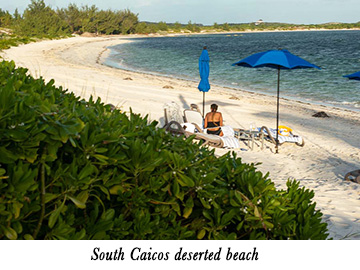 For decades, South Caicos has been an off-and-on destination for divers but devoid of diving facilities for the last several years. When I learned that Reef Divers from the Cayman Islands had purchased the stylish five-year-old East Bay Resort last July, it piqued my interest. Envisaged by the builders as a condo/timeshare resort with 87 units and many suites, Reef Divers is operating it as an all-inclusive vacation hotel catering to divers.
For decades, South Caicos has been an off-and-on destination for divers but devoid of diving facilities for the last several years. When I learned that Reef Divers from the Cayman Islands had purchased the stylish five-year-old East Bay Resort last July, it piqued my interest. Envisaged by the builders as a condo/timeshare resort with 87 units and many suites, Reef Divers is operating it as an all-inclusive vacation hotel catering to divers.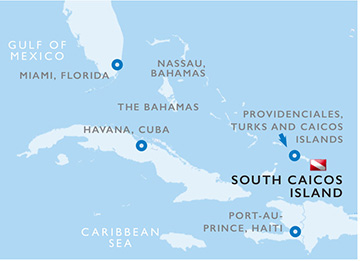 For our thorough predive briefings, our two
dive leaders channeled their inner Picassos by
good-naturedly competing on who had the most colorful and intricate whiteboard
drawings for the site. A typical boat ride was 10-20 minutes. In their customdesigned
46-foot Newtons, brought over from Little Cayman, aluminum benches ran
the boat's length, with the tanks stored in racks behind the benches. The flying
bridge extends halfway over the deck, providing ample shade for those who wish to stay out of the sun (midday temperature was in the 80s). It's a roomy boat with a head, plenty of space for the dozen divers on board, and could comfortably hold a few more. While they could have crammed all the divers in residence into two boats, they sent out three each day, a tribute to their regard for diver comfort.
For our thorough predive briefings, our two
dive leaders channeled their inner Picassos by
good-naturedly competing on who had the most colorful and intricate whiteboard
drawings for the site. A typical boat ride was 10-20 minutes. In their customdesigned
46-foot Newtons, brought over from Little Cayman, aluminum benches ran
the boat's length, with the tanks stored in racks behind the benches. The flying
bridge extends halfway over the deck, providing ample shade for those who wish to stay out of the sun (midday temperature was in the 80s). It's a roomy boat with a head, plenty of space for the dozen divers on board, and could comfortably hold a few more. While they could have crammed all the divers in residence into two boats, they sent out three each day, a tribute to their regard for diver comfort.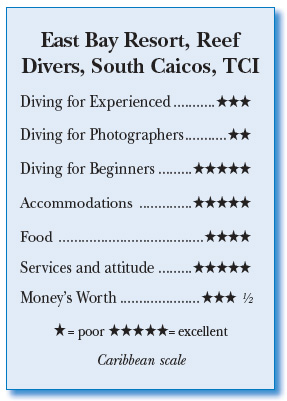 At the 50-foot-deep site Spanish Chain, the feature is, well, a large diameter chain without much encrustation. I was thrilled to see a pod of six bottlenose dolphins swim past maybe 50 feet away. And three eagle rays passed in a formation so tight and synchronized that they reminded me of the U.S. Navy's flight squadron, the Blue Angels. French grunts and schoolmasters were plentiful. During the surface interval, several tuna barreled out of the water six feet into the air, the culmination of an upward charge from the deep to nail unsuspecting sardines and other prey at the surface -- what a sight. And what a day.
At the 50-foot-deep site Spanish Chain, the feature is, well, a large diameter chain without much encrustation. I was thrilled to see a pod of six bottlenose dolphins swim past maybe 50 feet away. And three eagle rays passed in a formation so tight and synchronized that they reminded me of the U.S. Navy's flight squadron, the Blue Angels. French grunts and schoolmasters were plentiful. During the surface interval, several tuna barreled out of the water six feet into the air, the culmination of an upward charge from the deep to nail unsuspecting sardines and other prey at the surface -- what a sight. And what a day.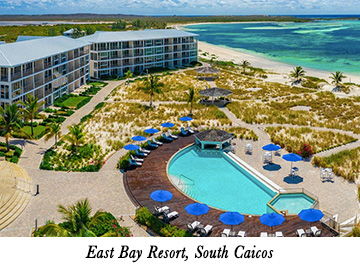 When it comes to diving, I don't expect big stuff at most Caribbean destinations, though I did see a Caribbean reef shark, a nurse shark, and several southern stingrays that had shimmied their way into the sand. If I approached them slowly, I could get close to their unique, deep-set eyes. While I wasn't looking much for small stuff, I did spot a few flamingo tongues and Christmas tree worms, but a photographer I dived with had difficulty locating many worthy macro subjects. The attentive guides, one in front and back of the group, pointed out things along the way, such as a high hat under a ledge. They'd leave the water back at the boat after 40 minutes, and I'd spend another 15-20 poking around. Though I never got deeper than 70 feet, I'd hang on the line for a safety stop.
When it comes to diving, I don't expect big stuff at most Caribbean destinations, though I did see a Caribbean reef shark, a nurse shark, and several southern stingrays that had shimmied their way into the sand. If I approached them slowly, I could get close to their unique, deep-set eyes. While I wasn't looking much for small stuff, I did spot a few flamingo tongues and Christmas tree worms, but a photographer I dived with had difficulty locating many worthy macro subjects. The attentive guides, one in front and back of the group, pointed out things along the way, such as a high hat under a ledge. They'd leave the water back at the boat after 40 minutes, and I'd spend another 15-20 poking around. Though I never got deeper than 70 feet, I'd hang on the line for a safety stop.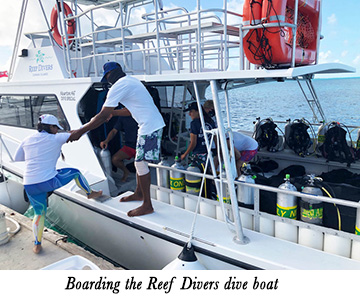 To get to South Caicos, it's a 15- minute flight from Providenciales ("Provo"), and that's where the chamber is. The South Caicos "terminal" was a pair of unairconditioned shipping containers with folding chairs inside, which, at least to me, added to the island's undiscovered charm. On a hot day, others might think differently.
To get to South Caicos, it's a 15- minute flight from Providenciales ("Provo"), and that's where the chamber is. The South Caicos "terminal" was a pair of unairconditioned shipping containers with folding chairs inside, which, at least to me, added to the island's undiscovered charm. On a hot day, others might think differently. Diver's Compass: Flying from Miami to Provo takes about an hour and 45 minutes; it's about three hours from Atlanta . . . after immigration, it's a 15-minute hop to South Caicos, population 1400 . . . Inter-Caribbean Airways has scheduled flights and Caicos Express Airways runs charters . . . My seven-night, all-inclusive stay cost $2,558/person, double occupancy, including round trip airfare from Provo, pickup and dropoff, all meals, and six days of two-tank morning dives . . . The van left at 8 a.m., 8:15, and 8:30 for the boat dock; a one-tank afternoon dive is $74 or $300 for five days . . . Nitrox for the week $150; 80 cu. ft. aluminum tanks were adequate for the dive profiles . . . currency is the U.S. dollar; electrical outlets are the same as in the U.S. . . . While nightlife is nonexistent, the island is clean and safe with mostly a scrubby grassy and bushy terrain... Eastbayresort.com and visittci.com
Diver's Compass: Flying from Miami to Provo takes about an hour and 45 minutes; it's about three hours from Atlanta . . . after immigration, it's a 15-minute hop to South Caicos, population 1400 . . . Inter-Caribbean Airways has scheduled flights and Caicos Express Airways runs charters . . . My seven-night, all-inclusive stay cost $2,558/person, double occupancy, including round trip airfare from Provo, pickup and dropoff, all meals, and six days of two-tank morning dives . . . The van left at 8 a.m., 8:15, and 8:30 for the boat dock; a one-tank afternoon dive is $74 or $300 for five days . . . Nitrox for the week $150; 80 cu. ft. aluminum tanks were adequate for the dive profiles . . . currency is the U.S. dollar; electrical outlets are the same as in the U.S. . . . While nightlife is nonexistent, the island is clean and safe with mostly a scrubby grassy and bushy terrain... Eastbayresort.com and visittci.com